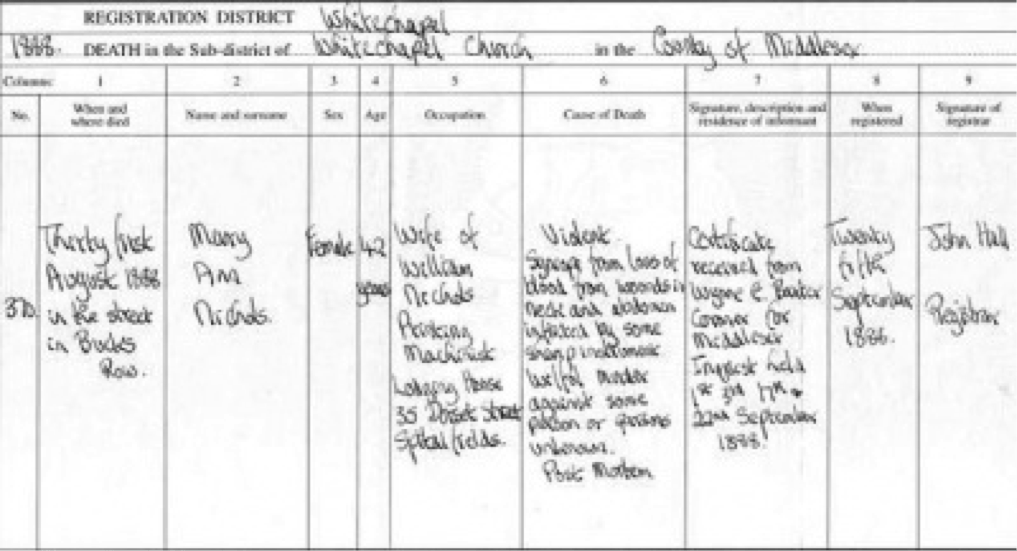Born on August 26, 1845 in London England, Mary Ann Walker was raised by locksmith Edward Walker and his wife Caroline. She married William Nichols, a printer’s machinist, in 1864; however, the couple divorced due to Mary’s drinking habits and prostitution allegations. Mary, now Mary Anne Nichols, continued practicing prostitution and was known for moving between workhouses and boarding houses, and living off charitable donations.

Prostitutes in Europe were regarded with mixed feelings in the nineteenth century. An awareness for the vulnerability of women prostitutes was fairly low and they were treated with curiosity as well as disgust. They had few economic options for making their way in the world and the women themselves were generally born into poverty and had little education or work skills. London prostitutes, especially those who operated on the streets, regularly picked the pockets of the men they preyed on. They kept an eye out for drunkards, from whom they could steal without the risk of being caught. However, this wasn’t the case with Mary as she herself spent most of her waking hours under the influence. Prostitution was very much frowned upon in London, and the women engaging in the profession were seen as the lowest of the low. It wasn’t unusual for men to beat and kill a prostitute after a ‘session,’ so when Mary Ann was found dead with her skirt lifted above her stomach, it was nothing out of the ordinary.1
The night in question was August 30, 1888. A heavy rain was falling on London during one of the coldest and wettest summers on record. Mary Ann was last seen walking down Whitechapel Road, and more than likely she was there soliciting her trade. Prostitution was a very dangerous profession one hundred thirty years ago. With no proper policing and the women themselves looked upon as animals, people would do with them as they pleased. No wonder the infamous ‘Jack the Ripper’s’ victims were all prostitutes.2 They were easy targets, and he was able to get away with murder.
Nichols was often found in the lodging house on 18 Thrawl Street; however, on this specific night she was knocked back due to a lack of money.3 Mary wasn’t fazed by this though, and was on her way back to her ‘office,’ the streets. At 2:30 am she ran into Emily Holland, another worker, who described Mary to be drunk and staggered against a wall. She told Emily that she was off to find another ‘punter’ in an attempt to get her ‘doss’ money in order to rest her head that night.4 One can’t help but think that Mary was selected by Jack because of her drunkenness and through no fault of her own she was destined to a brutal ending because she was such an easy victim. Emily Holland was the last known person to interact with Mary, and only one hour later, at 3:40 am, the latter was found cold and lifeless on the side of Bucks Row, a mere ten minutes walk from where the interaction took place.5

Constable Thain and Sergeant Kerby both passed down Bucks Row at 3:15, but reported nothing out of the ordinary. One must wonder what Nichols was doing from 2:30 to 3:40. She was only ten minutes away from Bucks Row, yet was found dead there seventy minutes later. Another thought would be: what was Jack the Ripper doing during that time. 6
Nichols’ body was initially found by two workmen, who both decided to leave her lying, as they didn’t want to be late for work. However, they let a police officer know her whereabouts on their way. Major bruising was found on Mary’s body and five of her teeth were missing. Investigators put this down to the struggle. Nevertheless, there were several deep cuts along her abdomen, which shows that her attacker enjoyed closeness with his victim, whom he supposedly raped and then mutilated. One can only speculate on why these cuts were made as they were, in no pattern, and didn’t relate to anything. As the first kill, maybe Jack was experimenting with Mary, and she was some sort of sick puppet in which his fantasies could be played out.7

Mary was buried on Thursday, September 6 of that year in the City of London’s Cemetery.8 Two days later, another of Jack’s victims, Annie Chapman, was found in the back garden of a London flat.9 Her womb had been removed and her body left horrifically mutilated. Jack the Ripper had indeed struck a second time. He wasted no time in preparing his second victim, yet this time it was more brutal than the first. One may wonder if Jack had attempted to remove Mary’s womb, but was perhaps disturbed and fled the scene before he could complete the operation.10 Jack the Ripper’s third victim was Elizabeth Stride. She was found at 1:00 am in Dutfield’s Yard, London. The fact that her throat had been cut, but the rest of her body had not been touched, led to speculation that her killer had been interrupted. This links with Mary Ann’s case because it is believed that Jack was also interrupted while working on her. One may believe that Jack liked the excitement of being caught, as he seemed to carry out his kills in the middle of streets. The fourth victim was found in Mitre Square in the City of London at 1:45 am. Catherine Eddowes was savagely mutilated by The Ripper, as her face was torn off and her uterus was missing along with her kidney. Clearly, Jack had not been interrupted this time. On November 9, the body of Mary Kelly was found in her room in Miller’s Court at 10:45 am. She had been virtually skinned to the bone and many experts believed that she was Jack the Ripper’s final victim. This was a fitting finale for the sick monster, as he chose a private area in order to carry out his most disturbing kill of all.11
For well over one hundred years since the time of the murder of Mary Ann and the rest of Jack’s victims, the identity of the killer has been regularly questioned, with nearly one hundred suspects having been named in the process. While many theories exist, none of them have proven to be indisputably convincing. Many think the Ripper was a commoner, possibly a butcher or other tradesman, who lived locally and was employed during the week, explaining why the murders occurred on or near the weekend. A lot of experts also agree that the Ripper was a local to Whitechapel. One of the most compelling suspects was Thomas Hayne Cutbush, who was a violent youth diagnosed insane at the time of the murders in 1888, and was believed to be wandering the streets of London throughout the time of the killings. Subsequently, the murders then stopped after Cutbush was locked up. Disappointingly, this information, along with more evidence, did not prove that Cutbush and Jack the Ripper were the same man; but there was enough evidence to keep Cutbush on the suspect list.12
The finger of suspicion was first pointed at Cutbush in 1894, by The Sun newspaper.13 The article claimed that despite the popular theory of the Ripper being dead, he was in fact a mental patient. The Sun’s detailed description clearly resembled that of Cutbush. The suspicion was that the Metropolitan Police covered up his guilt to avoid the embarrassing outcry that would have followed if the country’s most feared serial killer was found to be Superintendent Henry Cutbush’s nephew. Henry was a high ranked officer, whose reputation could have been seriously damaged if his relative was found to be Jack the Ripper. This is another reason why Thomas Cutbush was actively considered as a suspect.
Some named Cutbush as the No 1 Ripper suspect, but others have strongly denied this theory. Its main weakness is that the last known Ripper victim died in November 1888, at the end of the eleven week killing spree. If Cutbush was the killer, it seems odd that he would commit five murders over such short a period of time, stop for more than two years, and then commit one more assault, in which his victim survived. But there is almost no chance that the case will ever be solved. Thomas Hayne Cutbush remains top of the suspect list.14
It’s an eerie thought that this case will never be solved and even if it is, there is no one to suffer the consequences. It’s even scarier to think that there may currently still be serial killers on the run now that will also never be found and charged for their crimes. There will never be any justice for Jack the Rippers victims, but they can be certain they will never be forgotten.
- Mary Spongberg, The Body of the Female Prostitute in the Nineteenth-Century (New York, NY: New York University Press, 1997), 83-85. ↵
- Encyclopaedia Britannica, July 1998, s.v, “Jack the Ripper, English Murderer,” by John Phillip Jenkins. ↵
- Knocked back means dismissed. ↵
- A punter is a client. Doss is rent. ↵
- Stephen P. Ryder, “Casebook Jack the Ripper,” Victims: Last Addresses, August 14, 2009, 2, www.casebook.org/victims/polly.html. ↵
- Stephen P. Ryder, “Casebook Jack the Ripper.” Victims: Last Addresses, August 14, 2009, 2, www.casebook.org/victims/polly.html. ↵
- Salem Press Encyclopedia, January 2016, s.v. “Jack the Ripper,” by Cait Caffrey. ↵
- Death Certificate: no.370. 25 September, 1888. http://www.casebook.org/victims/polly.html ↵
- A back garden is a backyard. ↵
- William D. Rubenstien, “The Hunt For Jack the Ripper,” Ripper Diaries, (May 2000): 1-3. ↵
- Richard Jones, “Jack The Ripper 1888,” Victims (13 March 2016): 3. ↵
- Andy McSmith, “Madman’s notes throw new light on Ripper case,” The Independent article London, (19 November 2008). ↵
- A tabloid newspaper published in the United Kingdom and Ireland. ↵
- Richard Wheatsone, “Ripping Discovery,” The Sun (16 September 2017). ↵



211 comments
Montserrat Moreno Ramirez
Stories of Jack the Ripper have been around since I have memory and this article really makes it justice, to know who was his first victim and to know how he evolved in his murderers was just crazy. It’s even more crazy to know that the real murderer was never caught and as it says in the ending, nowadays there may be serial killers who will never be caught and punished for their crimes.
Damian Jennings
Jack the Ripper, a passionate man who chose the life of mutilating prostitutes. The culture in England was unspeakable, people would casually walk over dead prostitutes in the street because it was “normal”. Regardless of your practices or beliefs, no one deserves to be murdered in a cruel and unusual way. It amazes me that Jack was never pursued in anyway and remained a mystery to the people of England, his work was terrifying and brutal.
Mia Stahl
Jack the Ripper was a common subject in my childhood days. Stories of his crimes were told to scare children and to educate them about the perils of modern day society. One thing that I had not know before reading this article was the occupation of the women Jack the Ripper had chosen as his victims. This information totally flips the script for me in that it presents a whole new motive for murder as well as exhibiting the morals and modes of thought held by the people of this time.
Dylan Sanchez
Such a chilling article to read. I have vaguely heard of Jack the Ripper and after reading this I sorta wish I had stayed that way. The wording and storytelling of this article was superb and kept me wanting more of it. It’s such a scary thought that a human being was capable of committing these awful crimes to such vulnerable people. If only we could delve into the mind of Jack and see what his early life may have been. Good read.
Roman Olivera
Wow, what a thing to have engraved on the tomb stone where Mary Ann Walker was buried, victim of Jack the Ripper. Jack the Ripper has always been a fascination of many people who read up on serial killers. I think this has to do with the brutality of his crimes and the fact that he was never caught or even close to being caught. I like that there are many theories of who Jack the Ripper could have been and the number one suspect,Thomas Hayne Cutbush, is an easy one to pin it on because he was insane. I have heard everything from the butcher theory to the surgeon or medical student because of the precise cuts he gave his victims when removing organs. I think these murders will continue to be some of the most interesting because we will never know the why’s or the who in this case in regards to the killer. This case is far to old and the forensics were just not there at the time. ts sad to say but the way these murders were treated because they were prostitute women is unfortunate, but with that being said there are many cases today that don’t get a second look because of the victims social status. How far have we really come as a society, when where you are on the social economic latter comes into play, in regards to a crime being committed against you and where the person falls on the social latter that commits the crime. This was a very insightful article focusing on the victims of The Ripper and not just the mystery of who Jack the Ripper himself was, because that we will never know.
Jorge Martinez
I read this article is broad daylight, in the afternoon, in complete comfort and I was still spooked. The conclusion of crimes being unsolved, not being justified, ran chills down my spine. I really did not know much the Jack the Ripper, only that he was an infamous serial killer, and it was really cool to know more about him.
Maxx Arizmendi
I have heard of Jack the Ripper, and I didn’t know that this happened in England, and I also did not know that all of his victims were prostitutes. It seems like he killed those who were extremely vulnerable, and the best time to strike was in the early hours of the morning. I find it sickening that Jack the Ripper mutilated his victims horrifically, but nonetheless this article was a good read.
Martina Rodriguez
I had no idea the reputation of prostitutes during this time frame. It’s frustrating to think that if they had just been seen with the same human dignity as everyone else, the murders might have been less and Jack the Ripper could have been caught. I find it very odd that it took so many victims for the crimes to finally be connected to a serial killer. I cannot understand the aspect of removing the female reproductive organs. While I’ve heard of this case before, I had no idea that they had so many suspects, but also in the very least one as strong as Cutbush.
Indhira Mata
Jack the Ripper is one of the most famous and known murder case to police officers and serial killers of today. It is so unfair how the victims families never found any justice to who murdered their loved ones. I believe his killings were nothing more than him running away scared and afraid. I think he chose low risk victims because that is who he could confront. Someone more weak and vulnerable than him would mean he wouldn’t have to work as hard to take them down.
Crystal Baeza
It’s chilling knowing Jack the Ripper was never found and was remained unsolved. How can one cause so much harm to women and go on with their lives? I would agree a man would have to be insane to cause such gruesome acts. Throughout the article reading the different acts he did to the women sickened me. I’ll never understand how someone can hurt others and watch them suffer in pain. I’m saddened there will no justice for those innocent lives taken away with no explanation.